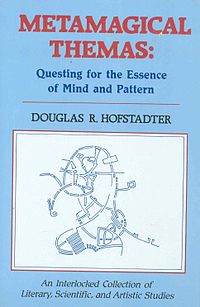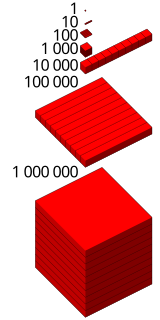Related Research Articles
The Berry paradox is a self-referential paradox arising from an expression like "The smallest positive integer not definable in under sixty letters".

Douglas Richard Hofstadter is an American scholar of cognitive science, physics, and comparative literature whose research includes concepts such as the sense of self in relation to the external world, consciousness, analogy-making, artistic creation, literary translation, and discovery in mathematics and physics. His 1979 book Gödel, Escher, Bach: An Eternal Golden Braid won both the Pulitzer Prize for general nonfiction and a National Book Award for Science. His 2007 book I Am a Strange Loop won the Los Angeles Times Book Prize for Science and Technology.

Self-reference occurs in natural or formal languages when a sentence, idea or formula refers to itself. The reference may be expressed either directly—through some intermediate sentence or formula—or by means of some encoding. In philosophy, it also refers to the ability of a subject to speak of or refer to itself, that is, to have the kind of thought expressed by the first person nominative singular pronoun "I" in English.
Gödel's incompleteness theorems are two theorems of mathematical logic that are concerned with the limits of provability in formal axiomatic theories. These results, published by Kurt Gödel in 1931, are important both in mathematical logic and in the philosophy of mathematics. The theorems are widely, but not universally, interpreted as showing that Hilbert's program to find a complete and consistent set of axioms for all mathematics is impossible.

Metamagical Themas is an eclectic collection of articles that Douglas Hofstadter wrote for the popular science magazine Scientific American during the early 1980s. The anthology was published in 1985 by Basic Books.
In economics and game theory, a participant is considered to have superrationality if they have perfect rationality but assume that all other players are superrational too and that a superrational individual will always come up with the same strategy as any other superrational thinker when facing the same problem. Applying this definition, a superrational player playing against a superrational opponent in a prisoner's dilemma will cooperate while a rationally self-interested player would defect.
73 (seventy-three) is the natural number following 72 and preceding 74. In English, it is the smallest natural number with twelve letters in its spelled out name.
In mathematics, and more particularly in number theory, primorial, denoted by "#", is a function from natural numbers to natural numbers similar to the factorial function, but rather than successively multiplying positive integers, the function only multiplies prime numbers.
The On-Line Encyclopedia of Integer Sequences (OEIS) is an online database of integer sequences. It was created and maintained by Neil Sloane while researching at AT&T Labs. He transferred the intellectual property and hosting of the OEIS to the OEIS Foundation in 2009. Sloane is chairman of the OEIS Foundation.
In the platonia dilemma introduced in Douglas Hofstadter's book Metamagical Themas, an eccentric trillionaire gathers 20 people together, and tells them that if one and only one of them sends them a telegram by noon the next day, that person will receive a billion dollars. If they receive more than one telegram, or none at all, no one will get any money, and cooperation between players is forbidden. In this situation, the superrational thing to do is to send a telegram with probability 1/20.

Self-referential humor, also known as self-reflexive humor or meta humor, is a type of comedic expression that—either directed toward some other subject, or openly directed toward itself—is self-referential in some way, intentionally alluding to the very person who is expressing the humor in a comedic fashion, or to some specific aspect of that same comedic expression. Self-referential humor expressed discreetly and surrealistically is a form of bathos. In general, self-referential humor often uses hypocrisy, oxymoron, or paradox to create a contradictory or otherwise absurd situation that is humorous to the audience.
An autogram is a sentence that describes itself in the sense of providing an inventory of its own characters. They were invented by Lee Sallows, who also coined the word autogram. An essential feature is the use of full cardinal number names such as "one", "two", etc., in recording character counts. Autograms are also called 'self-enumerating' or 'self-documenting' sentences. Often, letter counts only are recorded while punctuation signs are ignored, as in this example:

One million (1,000,000), or one thousand thousand, is the natural number following 999,999 and preceding 1,000,001. The word is derived from the early Italian millione, from mille, "thousand", plus the augmentative suffix -one.
100,000 (one hundred thousand) is the natural number following 99,999 and preceding 100,001. In scientific notation, it is written as 105.
In number theory, an odious number is a positive integer that has an odd number of 1s in its binary expansion.
208 is the natural number following 207 and preceding 209.
288 is the natural number following 287 and preceding 289. Because 288 = 2 · 12 · 12, it may also be called "two gross" or "two dozen dozen".
A sequence of six consecutive nines occurs in the decimal representation of the number pi, starting at the 762nd decimal place. It has become famous because of the mathematical coincidence and because of the idea that one could memorize the digits of π up to that point, which seems to suggest that π is rational. The earliest known mention of this idea occurs in Douglas Hofstadter's 1985 book Metamagical Themas, where Hofstadter states
I myself once learned 380 digits of π, when I was a crazy high-school kid. My never-attained ambition was to reach the spot, 762 digits out in the decimal expansion, where it goes "999999", so that I could recite it out loud, come to those six 9's, and then impishly say, "and so on!"
In recreational mathematics, a ban number is a number that does not contain a particular letter when spelled out in English; in other words, the letter is "banned." Ban numbers are not precisely defined, since some large numbers do not follow the standards of number names.
In mathematics, a Hofstadter sequence is a member of a family of related integer sequences defined by non-linear recurrence relations.
References
- ↑ Hofstadter, Douglas R. (1996), Metamagical Themas: Questing For The Essence Of Mind And Pattern, Basic Books, p. 44, ISBN 9780465045662 .
- 1 2 Cloitre, Benoit; Sloane, N. J. A.; Vandermast, Matthew J. (2003), "Numerical analogues of Aronson's sequence" (PDF), Journal of Integer Sequences, 6 (2003), Art. 03.2.2, arXiv: math/0305308 , Bibcode:2003JIntS...6...22C .